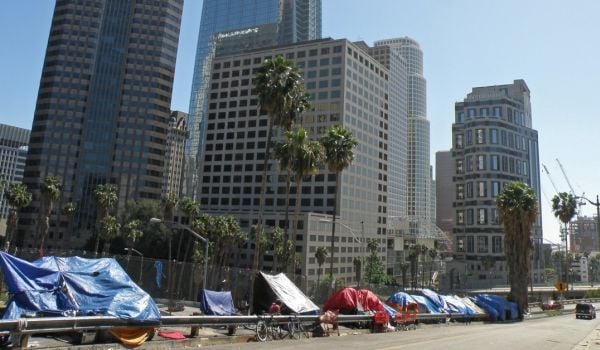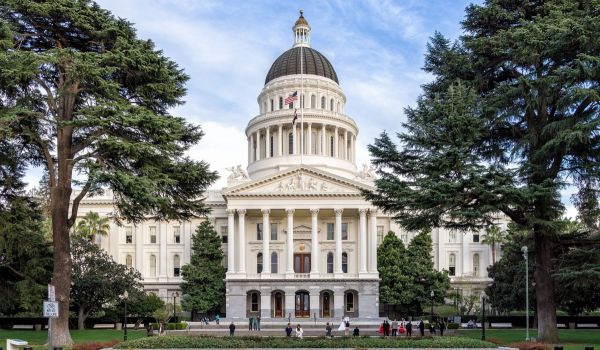Maps carry a certain authority to them.
Follow the orange line to reach the Hayward BART Station. Think twice about moving into that fire-risk zone. All your pan dulce needs can be met in this specific radius of the Mission District.
But “You Are Here: California Stories on the Map,” a new exhibit that just opened at Oakland Museum of California, wants people to think critically about who makes the maps they see and what story they’re trying to tell.
“Every map has a perspective,” said Sarah Seiter, guest curator of the exhibit. “Maps can be this tool for telling stories and sharing information, ideas and aspirations about the places we live.”
The exhibit encompasses more than 50 maps divided with segmented focus on climate change, nature, public health, community projects, and maps from a personal perspective. Contributors include the Anti-Eviction Mapping Project, West Oakland Environmental Indicators Project, naturalist artist Obi Kaufmann, How to Do Nothing: Resisting the Attention Economy author Jenny Odell, and everyday people.
The result is both a data-oriented and personal look at Oakland, the Bay Area, and California.
Maps visualize California’s growing wildfire problem in sprawling urban areas by comparing a 1951-1961 map, the first decade of reliable fire data, to 2008-2018. Another telling map from 1888 shows how real estate companies divided up coastal wetlands to create Alameda, Emeryville, West Oakland, and Bay Farm — and sounds the alarm on how Alameda today must brace for sea-level rise. Other maps simply list the language most spoken at home after English in Spanish by state, like Tagalog in California and Nevada and Somali in Minnesota.
Meanwhile, in the public transit section of the exhibit, both the original BART mockup that proposed lines further than what was ultimately built and a “decolonized” version are on display. Writer Kenji Liu named stations after local figures and groups that have shaped the Bay Area, such as Angela Davis, Harvey Milk, Dolores Huerta, Fred Korematsu, Oscar Grant, Richard Aoki, the Ramaytush tribe and more.
Varying personal maps chart the worker cooperatives of Arizmendi Bakery and Qulture Collective, or favorite fish tacos in the East Bay, like Livermore’s Posada On Wheels and Oakland’s Tacos Sinaloa truck. A truly personal map comes from Omar Mismar, who spent 30 days trying to get as close to Grindr users based on their provided geolocation. Based on his walks around the city, he mapped the Path of Love series in neon. Visitors to the exhibit can also create their own maps while there.
“Because we share the city together, all these personal maps we see have been really refreshing and connecting with community members,” Seiter said. “It’s just a really big celebration about what our community members bring to the table.”
Part of that includes community mapping efforts that can illuminate issues in new ways. The West Oakland Environmental Indicators Project, an environmental justice organization, started tracking air quality in 2000 in an area grappling with air pollution from nearby freeways, redlining and now gentrification. They strapped air pollution sensors to Google Street View cars, and their data will now guide city and state agencies monitoring air quality for the next two decades.
Gallery: Images from “You Are Here”
Similarly, the data visualization collective Anti-Eviction Mapping Project tracked evictions in San Francisco, finding that nearly half of evicted households surveyed stayed in the Bay Area, but one in five (21 percent) had to move out of California altogether. A pattern they noticed among those who left the state found they moved to cities like Detroit, Atlanta and Houston, and not cities with a similar tech boom like Seattle.
“People being evicted are going to cities on a different economic circuit,” said Mary Shi, a researcher with the group and a graduate student at the University of California Berkeley. This map kind of illustrates the disruptive potential of eviction but also makes super visible that once your neighbor gets kicked out across the street, you don’t necessarily see where they ended up.”
Another project on display takes excerpts from The California Field Atlas, a book created and illustrated by Obi Kaufmann. The Atlas, an illustrative approach to the state’s topography, encompasses the state’s expansive geography and ecology. Kaufmann said he had to reverse-engineer the maps, which are often buried deep in government websites.
“Those maps have a very scientific purpose,” Kaufmann says. “That story isn’t for you. I wanted to gather all the maps together and give them to you … and by you, I mean me.”
The general key to maps, Kaufmann tells Next City, is to “let them breathe” with a narrow focus, even if it takes making dozens of different ones. Otherwise, they’ll be stuffed with too much information that gets lost. That’s part of the idea behind the Field Atlas’s next iteration, The Forests of California, scheduled for release in September.
Approachability is also front and center for Amy Mason, who is blind. Her tactile map about her first week in Oakland last summer was about sharing the world of maps with people who lack the opportunity to digest strictly visual maps.
“So much of what I think is missed by people who are blind is the opportunity to gather so much information that is presented only in [a] visual medium,” Mason said. “ My map was a personal journey but also kind of built so I can have us help us think about how we can make maps inclusive.”
“You Are Here: California Stories on the Map” on display at Oakland Museum of California through Feb. 28, 2022.
This article is part of “For Whom, By Whom,” a series of articles about how creative placemaking can expand opportunities for low-income people living in disinvested communities. This series is generously underwritten by the Kresge Foundation.

Ida Mojadad is SF Weekly's staff writer, often covering politics, housing and transportation. Her words can also be found in the Orange County Register, KQED (NPR), Faribault Daily News, Northfield News and SF Examiner. You can find more of her work at idamojadad.com.




















